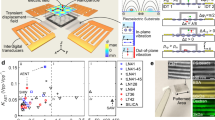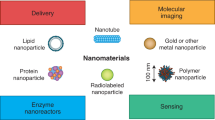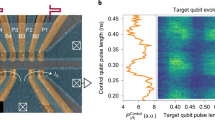Abstract
For some decades now, nanotechnology has been touted as the 'next big thing' with potential impact comparable to the steam, electricity or Internet revolutions — but has it lived up to these expectations? While advances in top-down nanolithography, now reaching 10-nm resolution, have resulted in devices that are rapidly approaching mass production, attempts to produce nanoscale devices using bottom-up approaches have met with only limited success. We have been inundated with nanoparticles of almost any shape, material and composition, but their societal impact has been far from revolutionary, with growing concerns over their toxicity. Despite nebulous hopes that making hierarchical nanomaterials will lead to new, emergent properties, no breakthrough applications seem imminent. In this Perspective, we argue that the time is ripe to look beyond individual nano-objects and their static assemblies, and instead focus on systems comprising different types of 'nanoparts' interacting and/or communicating with one another to perform desired functions. Such systems are interesting for a variety of reasons: they can act autonomously without external electrical or optical connections, can be dynamic and reconfigurable, and can act as 'nanomachines' by directing the flow of mass, energy or information . In thinking how this systems nanoscience approach could be implemented to design useful — as opposed to toy-model — nanosystems, our choice of applications and our nanoengineering should be inspired by living matter.
This is a preview of subscription content, access via your institution
Access options
Subscribe to this journal
Receive 12 print issues and online access
$259.00 per year
only $21.58 per issue
Buy this article
- Purchase on Springer Link
- Instant access to full article PDF
Prices may be subject to local taxes which are calculated during checkout






Similar content being viewed by others
References
Lutkenhaus, J. Assembly dynamics of the bacterial MinCDE system and spatial regulation of the Z ring. Annu. Rev. Biochem. 76, 539–562 (2007).
Soh, S., Byrska, M., Kandere-Grzybowska, K. & Grzybowski, B. A. Reaction–diffusion systems in intracellular molecular transport and control. Angew. Chem. Int. Ed. 49, 4170–4198 (2010).
Funke, J. J. & Dietz, H. Placing molecules with Bohr radius resolution using DNA origami. Nature Nanotech. 11, 47–52 (2016).
Bishop, K. J. M., Wilmer, C. E., Soh, S. & Grzybowski, B. A. Nanoscale forces and their uses in self-assembly. Small 5, 1600–1630 (2009).
Ke, Y., Ong, L. L., Shih, W. M. & Yin, P. Three-dimensional structures self-assembled from DNA bricks. Science 338, 1177–1183 (2012).
Fialkowski, M. et al. Principles and implementations of dissipative (dynamic) self-assembly. J. Phys. Chem. B 110, 2482–2496 (2006).
Ley, S. V. et al. Machine-assisted organic synthesis. Angew. Chem. Int. Ed. 54, 10122–10136 (2105).
Klajn, R., Bishop, K. J. M. & Grzybowski, B. A. Light-controlled self-assembly of reversible and irreversible nanoparticle suprastructures. Proc. Natl Acad. Sci. USA 104, 10305–10309 (2007).
Ragazzon, G. et al. Light-powered autonomous and directional molecular motion of a dissipative self-assembling system. Nature Nanotech. 10, 70–75 (2015).
Boekhoven, J. et al. Transient assembly of active materials fuelled by a chemical reaction. Science 349, 1075–1079 (2015).
Paxton, W. F. et al. Catalytic nanomotors: autonomous movement of striped nanorods. J. Am. Chem. Soc. 126, 13424–13431 (2004).
Paxton, W. F., Sundararajan, S., Mallouk, T. E. & Sen, A. Chemical locomotion. Angew. Chem. Int. Ed. 45, 5420–5429 (2006).
Soto, R. & Golestanian, R. Self-assembly of catalytically active colloidal molecules: tailoring activity through surface chemistry. Phys. Rev. Lett. 112, 068301 (2014).
Novak, B. & Tyson, J. J. Design principles of biochemical oscillators. Nature Rev. Mol. Cell Biol. 9, 981–991 (2008).
Tsang, J., Zhu, J. & van Oudenaarden, A. MicroRNA-mediated feedback and feedforward loops are recurrent network motifs in mammals. Mol. Cell 26, 753–767 (2007).
Yi, T. M., Huang, Y., Simon, M. I. & Doyle, J. Robust perfect adaptation in bacterial chemotaxis through integral feedback control. Proc. Natl Acad. Sci. USA 97, 4649–4653 (2000).
Giuseppone, N. Toward self-constructing materials: a systems chemistry approach. Acc. Chem. Res. 45, 2178–2188 (2012).
Semenov, S. Y. et al. Rational design of functional and tunable oscillating enzymatic networks. Nature Chem. 7, 160–165 (2015).
Epstein, I. & Pojman, J. An Introduction to Nonlinear Chemical Dynamics: Oscillations, Waves, Patterns, and Chaos (Oxford Univ. Press, 1998).
Lagzi, I., Kowalczyk, B., Wang, D. W. & Grzybowski, B. A. Nanoparticle oscillations and fronts. Angew. Chem. Int. Ed. 49, 8616–8619 (2010).
Nowak, P., Colomb-Delsue, M., Otto, S. & Li, J. W. Template-triggered emergence of a self-replicator from a dynamic combinatorial library. J. Am. Chem. Soc. 137, 10965–10969 (2015).
Mattia, E. & Otto, S. Supramolecular systems chemistry. Nature Nanotech. 10, 111–119 (2015).
He, X. M. et al. Synthetic homeostatic materials with chemo-mechano-chemical self-regulation. Nature 487, 214–218 (2012).
Grzybowski, B. A. et al. Micro- and nanotechnology via reaction–diffusion. Soft Matter 1, 114–128 (2005).
Bishop, K. J. M. & Grzybowski, B. A. Localized chemical wave emission and mode switching in a patterned excitable medium. Phys. Rev. Lett. 97, 128702 (2006).
Semenov, S. N., Markvoort, A. J., deGreef, T. F. A. & Huck, W. T. S. Threshold sensing through a synthetic enzymatic reaction–diffusion network. Angew. Chem. Int. Ed. 53, 8066–8069 (2014).
Semenov, S. N. et al. Ultrasensitivity by molecular titration in spatially propagating enzymatic reactions. Biophys. J. 105, 1057–1066 (2013).
Epstein, I. R. Coupled chemical oscillators and emergent system properties. Chem. Commun. 50, 10758–10767 (2014).
Vanag, V. K. & Epstein, I. R. Segmented spiral waves in a reaction–diffusion system. Proc. Natl Acad. Sci. USA 100, 14635–14638 (2003).
Gimenez, C. et al. Towards chemical communication between gated nanoparticles. Angew. Chem. Int. Ed. 53, 12629–12633 (2014).
Steinberg-Yfrach, G. et al. Light-driven production of ATP catalysed by F0F1-ATP synthase in an artificial photosynthetic membrane. Nature 392, 479–482 (1998).
Klajn, R., Stoddart, J. F. & Grzybowski, B. A. Nanoparticles functionalised with reversible molecular and supramolecular switches. Chem. Soc. Rev. 39, 2203–2237 (2010).
Kim, Y., Macfarlane, R. J., Jones, M. R. & Mirkin, C. A. Transmutable nanoparticles with reconfigurable surface ligands. Science 351, 579–582 (2016).
Saha, K., Agasti, S. S., Kim, C., Li, X. & Rotello, V. M. Gold nanoparticles in chemical and biological sensing. Chem. Rev. 112, 2739–2779 (2012).
Pillai, P., Kowalczyk, B. & Grzybowski, B. A. Controlled pH stability and adjustable cellular uptake of mixed-charge nanoparticles. J. Am. Chem. Soc. 135, 6392–6395 (2013).
Walker, D. A., Leitsch, E. K., Nap, R., Szleifer, I. & Grzybowski, B. A. Geometric curvature controls the chemical patchiness and self-assembly of nanoparticles. Nature Nanotech. 8, 676–681 (2013).
Tonga, G. Y. et al. Supramolecular regulation of bioorthogonal catalysis in cells using nanoparticle-embedded transition metal catalysts. Nature Chem. 7, 597–603 (2015).
Orelle, C. et al. Protein synthesis by ribosomes with tethered subunits. Nature 524, 119–124 (2015).
Wei, Y., Han, S., Kim, J., Soh, S. & Grzybowski, B. A. Photoswitchable catalysis mediated by dynamic aggregation of nanoparticles. J. Am. Chem. Soc. 132, 11018–11020 (2010).
Stano, P. & Luisi, P. L. Semi-synthetic minimal cells: origin and recent developments. Curr. Opin. Biotechnol. 24, 633–638 (2013).
Blain, J. C. & Szostak, J. W. Progress toward synthetic cells. Annu. Rev. Biochem. 83, 615–640 (2014).
Fallah-Araghi, A. Enhanced chemical synthesis at soft interfaces: a universal reaction–adsorption mechanism in microcompartments. Phys. Rev. Lett. 112, 028301 (2014).
Weitz, M. et al. Diversity in the dynamical behaviour of a compartmentalized programmable biochemical oscillator. Nature Chem. 6, 295–302 (2014).
Wu, F., van Schie, B. G. C., Keymer, J. E. & Dekker, C. Symmetry and scale orient Min protein patterns in shaped bacterial sculptures. Nature Nanotech. 10, 719–726 (2015).
Astumian, R. D. & Hänggi, P. Brownian motors. Phys. Today 55, 33–39 (November, 2002).
Zhang, R., Walker, D. A., Grzybowski, B. A. & de la Cruz, M. O. Accelerated self-replication under non-equilibrium, periodic energy delivery. Angew. Chem. Int. Ed. 53, 173–177 (2014).
Cheng, X., Merchan, L., Tchernookov, M. & Nemenman, I. A large number of receptors may reduce cellular response time variation. Phys. Biol. 10, 035008 (2013).
McKeithan, T. Kinetic proofreading in T-cell receptor signal transduction. Proc. Natl Acad. Sci. USA 92, 5042–5046 (1995).
Jeong, J. W. et al. Capacitive epidermal electronics for electrically safe, long-term electrophysiological measurements. Adv. Health. Mater. 3, 642–648 (2014).
Jeong, J. W. et al. Wireless optofluidic systems for programmable in vivo pharmacology and optogenetics. Cell 162, 662–674 (2015).
Acknowledgements
B.A.G. acknowledges the support of the Institute for Basic Science Korea, Project Code IBS-R020-D1. W.T.S.H. acknowledges support from the Ministry of Education, Culture and Science (Gravitation programme 024.001.035).
Author information
Authors and Affiliations
Corresponding authors
Ethics declarations
Competing interests
The authors declare no competing financial interests.
Rights and permissions
About this article
Cite this article
Grzybowski, B., Huck, W. The nanotechnology of life-inspired systems. Nature Nanotech 11, 585–592 (2016). https://doi.org/10.1038/nnano.2016.116
Received:
Accepted:
Published:
Issue Date:
DOI: https://doi.org/10.1038/nnano.2016.116
This article is cited by
-
Interlinking spatial dimensions and kinetic processes in dissipative materials to create synthetic systems with lifelike functionality
Nature Nanotechnology (2024)
-
Regulation of species metabolism in synthetic community systems by environmental pH oscillations
Nature Communications (2023)
-
Light-driven nucleation, growth, and patterning of biorelevant crystals using resonant near-infrared laser heating
Nature Communications (2023)
-
Functional advantages of building nanosystems using multiple molecular components
Nature Chemistry (2023)
-
Emergence of energy-avoiding and energy-seeking behaviors in nonequilibrium dissipative quantum systems
Communications Physics (2022)



